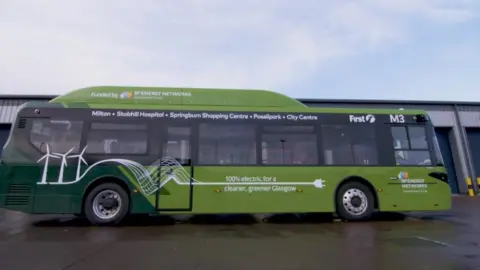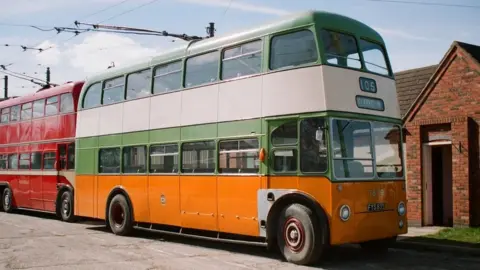Electric buses launched in Glasgow in bid to cut emissions
 BBC
BBCElectric buses are being launched in Glasgow on a commercial route for the first time since the 1960s.
Bus company First Glasgow said the introduction of the two vehicles was a "statement of intent" as Glasgow aims to become a "net zero" city.
Electric trolley buses previously operated in the city until they were decommissioned in 1967.
The new buses will run on the M3 route, connecting Milton and Springburn with Stobhill Hospital and the city centre.
They were built in Falkirk by Alexander Dennis and they were bought for First Glasgow with funding from electricity distributor SP Energy Networks.
Described as "state of the art", the buses have "mirrorless smartvision technology" - high definition digital cameras and an interior screen.
The bus firm says it removes the need for wing mirrors, helps reduce blind spots and the effects of bad weather on their vision.
They also have USB charging points, on-board audio-visual next stop announcements and free wi-fi.
Low emissions zone
Their introduction comes after Glasgow became the first Scottish city to have a low emissions zone, where emissions standards must be met by 20% of buses which pass through the city centre.
All vehicles entering the zone from December 2022 will have to meet the standards.
Operator First said it was already 40% compliant with the regulations and it has promised to introduce more low-emissions buses.
Managing director Andrew Jarvis said the business wanted to make buses "part of the solution" to improve air quality in the city.
The new buses will make bus travel easier and more convenient for travellers as well as being better for the environment, he said.
"Every customer journey on the route will save around 2kg of CO2 compared with driving on your own in an average car, making bus the best choice in reducing the impact on the planet," he added.

Back to the future for electric traction
 P L Chadwick/Geograph
P L Chadwick/GeographGlasgow last had all-electric buses in the 1960s.
The city started to develop a network of trolleybuses in 1949.
It was hoped they could combine some of the advantages of trams with the ability to steer round obstacles such as parked vehicles.
But in 1967 they were phased out for what was seen as a more modern technology - the diesel bus.
One the last of the Glasgow trolleybuses ended up as an exhibit at the Trolleybus Museum at Sandtoft in Lincolnshire.

One of the new buses will be displayed at Glasgow's Riverside Museum over the weekend, before going into service on Monday.
The project has been financed through SP Energy Networks' £20m Green Economy Fund.
It is also backing the installation of 22 electric vehicle charging points in First Glasgow's Caledonia depot.
Its chief executive Frank Mitchell said Glasgow's ambition to be the UK's first net zero carbon city by 2030 would require "big changes".
"The introduction of the low emission zone was the cities first big test and sets out a marker for its ambitions," he said.
"The introduction of this new electric bus technology which will ultimately improve air quality and noise pollution in the city centre and other communities."
